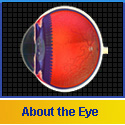
Glossary of Terms
Aqueous humor: The clear, watery fluid between the cornea and the lens that helps the eyeball keep its shape.
Choroid: The membrane located between the retina and the sclera. The choroids carry the blood supply that nourishes the eye’s internal structures.
Cones: The cone cells are located in the central part of the retina. This area is responsible for producing sharp, detail vision and color vision.
Cornea: The clear, dome-shaped surface that covers the front of the eye.
Crystalline lens: Transparent body located behind the iris that focuses light waves on the retina.
Iris: The part of the eye that surrounds the pupil and gives the eye its color. The iris controls the amount of light that reaches the retina.
Lens: A thin, transparent structure behind the iris and the pupil that focuses light rays onto the retina.
Macula: The central area of the retina, consisting of cones only.
Optic Nerve: A collection of nerve cells that exits the back of the eye and carries visual impulses from the retina to the brain, where they are then interpreted in the primary visual cortex.
Pupil: The dark center in the middle of the iris through which light passes to the back of the eye.
Retina: The light processing membrane located at the back of the eye. The retina is responsible for converting light into electrical impulses, which are then transmitted to the optic nerve. The retina is similar to film inside a camera.
Rods: Long, slender structures located within the peripheral retina that provide vision in dim light.
Sclera: The white, fibrous outer membrane of the eye. The sclera helps maintain the shape of the eyeball.
Stroma: The cornea’s middle layer.
Vitreous humor: The clear, gel-like fluid behind the lens and pupil.
How Does the Eye Work?
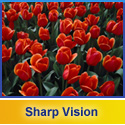 Understanding the complex nature of your vision is an important step in maintaining quality eye care. Below is a basic overview of how the eye works. If you have any questions regarding this information, please feel free to call North County Laser Eye Associates in Carlsbad. We will be happy to answer all of your questions.
Understanding the complex nature of your vision is an important step in maintaining quality eye care. Below is a basic overview of how the eye works. If you have any questions regarding this information, please feel free to call North County Laser Eye Associates in Carlsbad. We will be happy to answer all of your questions.
There are many complex structures within the eye that work together to produce an image. These internal structures work together with the brain to form an image.
Here is how it works:
The eye works much like a camera. First, light rays enter the eye through the cornea and the pupil. The light travels through the eye and is focused onto the retina by the lens. The light continues through the vitreous humor and back to the retina. In the retina, rods and cones convert the light waves to electrical impulses through a series of chemical reactions. These electrical impulses are sent along the optic nerve to the brain, which interprets the impulses into visual images.
The cornea and the lens join together to help the eye focus clearly. The cornea’s shape is fixed, but the lens can modify its shape to change focus, which is how we adjust our focus from near objects to distant objects. An abnormally shaped cornea can result in an inability to focus images clearly, which is commonly known as nearsightedness (myopia), farsightedness (hyperopia), and astigmatism.
Nearsightedness (Myopia)
 Nearsightedness, or myopia, is the result of an eyeball that is longer than normal from front to back, which causes the light to be focused at a point in front of the retina. People who suffer from myopia have difficulty seeing objects at a distance, while close vision is clear. Myopia can be corrected with glasses, contact lenses, or laser surgery, such as LASIK or ASA (Advanced Surface Ablation).
Nearsightedness, or myopia, is the result of an eyeball that is longer than normal from front to back, which causes the light to be focused at a point in front of the retina. People who suffer from myopia have difficulty seeing objects at a distance, while close vision is clear. Myopia can be corrected with glasses, contact lenses, or laser surgery, such as LASIK or ASA (Advanced Surface Ablation).
Farsightedness (Hyperopia)
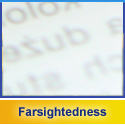 Farsightedness, or hyperopia, is the result of an eyeball that is shorter than normal, which causes the light rays to focus behind the retina. People who suffer from hyperopia can see objects at a distant but have difficulty seeing objects up close. Hyperopia can be corrected with glasses, contact lenses, or refractive surgery, such as LASIK or ASA (Advanced Surface Ablation).
Farsightedness, or hyperopia, is the result of an eyeball that is shorter than normal, which causes the light rays to focus behind the retina. People who suffer from hyperopia can see objects at a distant but have difficulty seeing objects up close. Hyperopia can be corrected with glasses, contact lenses, or refractive surgery, such as LASIK or ASA (Advanced Surface Ablation).
Astigmatism
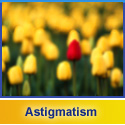 Astigmatism, which is the most common vision problem, occurs when the cornea has an oblong shape, rather than a spherical shape. The abnormal shape causes light to focus on two points in the back of the eye, resulting in blurry vision. Astigmatism can be corrected with glasses, contacts, or refractive surgery, such as LASIK or ASA (Advanced Surface Ablation).
Astigmatism, which is the most common vision problem, occurs when the cornea has an oblong shape, rather than a spherical shape. The abnormal shape causes light to focus on two points in the back of the eye, resulting in blurry vision. Astigmatism can be corrected with glasses, contacts, or refractive surgery, such as LASIK or ASA (Advanced Surface Ablation).
Presbyopia
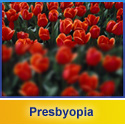 Presbyopia occurs when the lens loses its flexibility and can no longer change shape. Presbyopia is a natural part of the aging process. In fact, it happens to everyone at some point in life (typically around age 40), even to those who have had perfect vision their whole life. Presbyopia makes it difficult to focus on near objects, so you may find that you have to hold objects at arm’s length to see them clearly.
Presbyopia occurs when the lens loses its flexibility and can no longer change shape. Presbyopia is a natural part of the aging process. In fact, it happens to everyone at some point in life (typically around age 40), even to those who have had perfect vision their whole life. Presbyopia makes it difficult to focus on near objects, so you may find that you have to hold objects at arm’s length to see them clearly.
If you want to learn more about how the eye works, or if you want to schedule an eye appointment, contact North County Laser Eye Associates in Carlsbad today.



